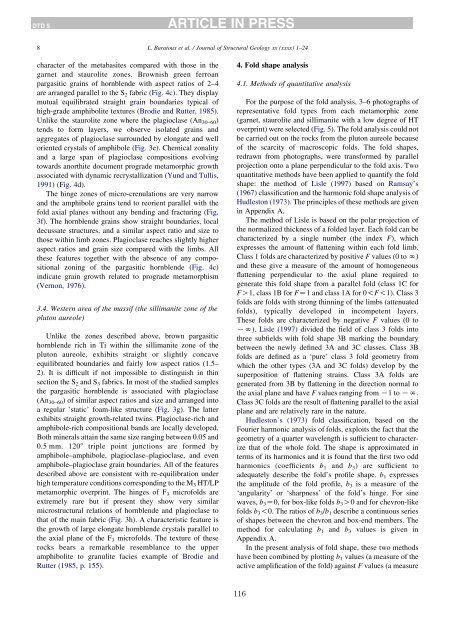Quantitative structural analyses and numerical modelling of ...
Quantitative structural analyses and numerical modelling of ...
Quantitative structural analyses and numerical modelling of ...
Create successful ePaper yourself
Turn your PDF publications into a flip-book with our unique Google optimized e-Paper software.
DTD 5ARTICLE IN PRESS8L. Baratoux et al. / Journal <strong>of</strong> Structural Geology xx (xxxx) 1–24character <strong>of</strong> the metabasites compared with those in thegarnet <strong>and</strong> staurolite zones. Brownish green ferroanpargasitic grains <strong>of</strong> hornblende with aspect ratios <strong>of</strong> 2–4are arranged parallel to the S 2 fabric (Fig. 4c). They displaymutual equilibrated straight grain boundaries typical <strong>of</strong>high-grade amphibolite textures (Brodie <strong>and</strong> Rutter, 1985).Unlike the staurolite zone where the plagioclase (An 30–60 )tends to form layers, we observe isolated grains <strong>and</strong>aggregates <strong>of</strong> plagioclase surrounded by elongate <strong>and</strong> welloriented crystals <strong>of</strong> amphibole (Fig. 3e). Chemical zonality<strong>and</strong> a large span <strong>of</strong> plagioclase compositions evolvingtowards anorthite document prograde metamorphic growthassociated with dynamic recrystallization (Yund <strong>and</strong> Tullis,1991) (Fig. 4d).The hinge zones <strong>of</strong> micro-crenulations are very narrow<strong>and</strong> the amphibole grains tend to reorient parallel with thefold axial planes without any bending <strong>and</strong> fracturing (Fig.3f). The hornblende grains show straight boundaries, localdecussate structures, <strong>and</strong> a similar aspect ratio <strong>and</strong> size tothose within limb zones. Plagioclase reaches slightly higheraspect ratios <strong>and</strong> grain size compared with the limbs. Allthese features together with the absence <strong>of</strong> any compositionalzoning <strong>of</strong> the pargasitic hornblende (Fig. 4c)indicate grain growth related to prograde metamorphism(Vernon, 1976).3.4. Western area <strong>of</strong> the massif (the sillimanite zone <strong>of</strong> thepluton aureole)Unlike the zones described above, brown pargasitichornblende rich in Ti within the sillimanite zone <strong>of</strong> thepluton aureole, exhibits straight or slightly concaveequilibrated boundaries <strong>and</strong> fairly low aspect ratios (1.5–2). It is difficult if not impossible to distinguish in thinsection the S 2 <strong>and</strong> S 3 fabrics. In most <strong>of</strong> the studied samplesthe pargasitic hornblende is associated with plagioclase(An 30–60 ) <strong>of</strong> similar aspect ratios <strong>and</strong> size <strong>and</strong> arranged intoa regular ’static’ foam-like structure (Fig. 3g). The latterexhibits straight growth-related twins. Plagioclase-rich <strong>and</strong>amphibole-rich compositional b<strong>and</strong>s are locally developed.Both minerals attain the same size ranging between 0.05 <strong>and</strong>0.5 mm. 1208 triple point junctions are formed byamphibole–amphibole, plagioclase–plagioclase, <strong>and</strong> evenamphibole–plagioclase grain boundaries. All <strong>of</strong> the featuresdescribed above are consistent with re-equilibration underhigh temperature conditions corresponding to the M 3 HT/LPmetamorphic overprint. The hinges <strong>of</strong> F 3 micr<strong>of</strong>olds areextremely rare but if present they show very similarmicro<strong>structural</strong> relations <strong>of</strong> hornblende <strong>and</strong> plagioclase tothat <strong>of</strong> the main fabric (Fig. 3h). A characteristic feature isthe growth <strong>of</strong> large elongate hornblende crystals parallel tothe axial plane <strong>of</strong> the F 3 micr<strong>of</strong>olds. The texture <strong>of</strong> theserocks bears a remarkable resemblance to the upperamphibolite to granulite facies example <strong>of</strong> Brodie <strong>and</strong>Rutter (1985, p. 155).4. Fold shape analysis4.1. Methods <strong>of</strong> quantitative analysisFor the purpose <strong>of</strong> the fold analysis, 3–6 photographs <strong>of</strong>representative fold types from each metamorphic zone(garnet, staurolite <strong>and</strong> sillimanite with a low degree <strong>of</strong> HToverprint) were selected (Fig. 5). The fold analysis could notbe carried out on the rocks from the pluton aureole because<strong>of</strong> the scarcity <strong>of</strong> macroscopic folds. The fold shapes,redrawn from photographs, were transformed by parallelprojection onto a plane perpendicular to the fold axis. Twoquantitative methods have been applied to quantify the foldshape: the method <strong>of</strong> Lisle (1997) based on Ramsay’s(1967) classification <strong>and</strong> the harmonic fold shape analysis <strong>of</strong>Hudleston (1973). The principles <strong>of</strong> these methods are givenin Appendix A.The method <strong>of</strong> Lisle is based on the polar projection <strong>of</strong>the normalized thickness <strong>of</strong> a folded layer. Each fold can becharacterized by a single number (the index F), whichexpresses the amount <strong>of</strong> flattening within each fold limb.Class 1 folds are characterized by positive F values (0 to N)<strong>and</strong> these give a measure <strong>of</strong> the amount <strong>of</strong> homogeneousflattening perpendicular to the axial plane required togenerate this fold shape from a parallel fold (class 1C forFO1, class 1B for FZ1 <strong>and</strong> class 1A for 0!F!1). Class 3folds are folds with strong thinning <strong>of</strong> the limbs (attenuatedfolds), typically developed in incompetent layers.These folds are characterized by negative F values (0 toKN). Lisle (1997) divided the field <strong>of</strong> class 3 folds intothree subfields with fold shape 3B marking the boundarybetween the newly defined 3A <strong>and</strong> 3C classes. Class 3Bfolds are defined as a ‘pure’ class 3 fold geometry fromwhich the other types (3A <strong>and</strong> 3C folds) develop by thesuperposition <strong>of</strong> flattening strains. Class 3A folds aregenerated from 3B by flattening in the direction normal tothe axial plane <strong>and</strong> have F values ranging from K1toKN.Class 3C folds are the result <strong>of</strong> flattening parallel to the axialplane <strong>and</strong> are relatively rare in the nature.Hudleston’s (1973) fold classification, based on theFourier harmonic analysis <strong>of</strong> folds, exploits the fact that thegeometry <strong>of</strong> a quarter wavelength is sufficient to characterizethat <strong>of</strong> the whole fold. The shape is approximated interms <strong>of</strong> its harmonics <strong>and</strong> it is found that the first two oddharmonics (coefficients b 1 <strong>and</strong> b 3 ) are sufficient toadequately describe the fold’s pr<strong>of</strong>ile shape. b 1 expressesthe amplitude <strong>of</strong> the fold pr<strong>of</strong>ile, b 3 is a measure <strong>of</strong> the‘angularity’ or ‘sharpness’ <strong>of</strong> the fold’s hinge. For sinewaves, b 3 Z0, for box-like folds b 3 O0 <strong>and</strong> for chevron-likefolds b 3 !0. The ratios <strong>of</strong> b 3 /b 1 describe a continuous series<strong>of</strong> shapes between the chevron <strong>and</strong> box-end members. Themethod for calculating b 1 <strong>and</strong> b 3 values is given inAppendix A.In the present analysis <strong>of</strong> fold shape, these two methodshave been combined by plotting b 1 values (a measure <strong>of</strong> theactive amplification <strong>of</strong> the fold) against F values (a measure116







